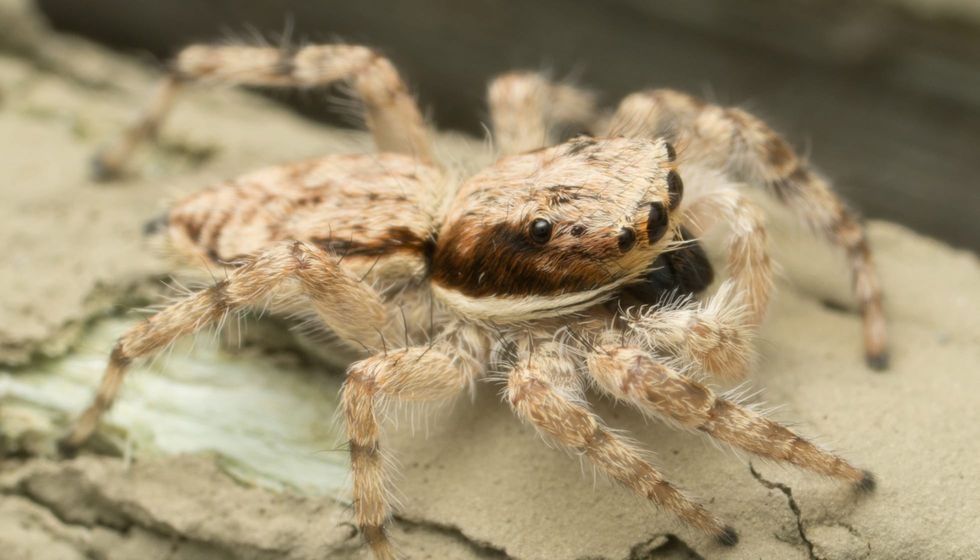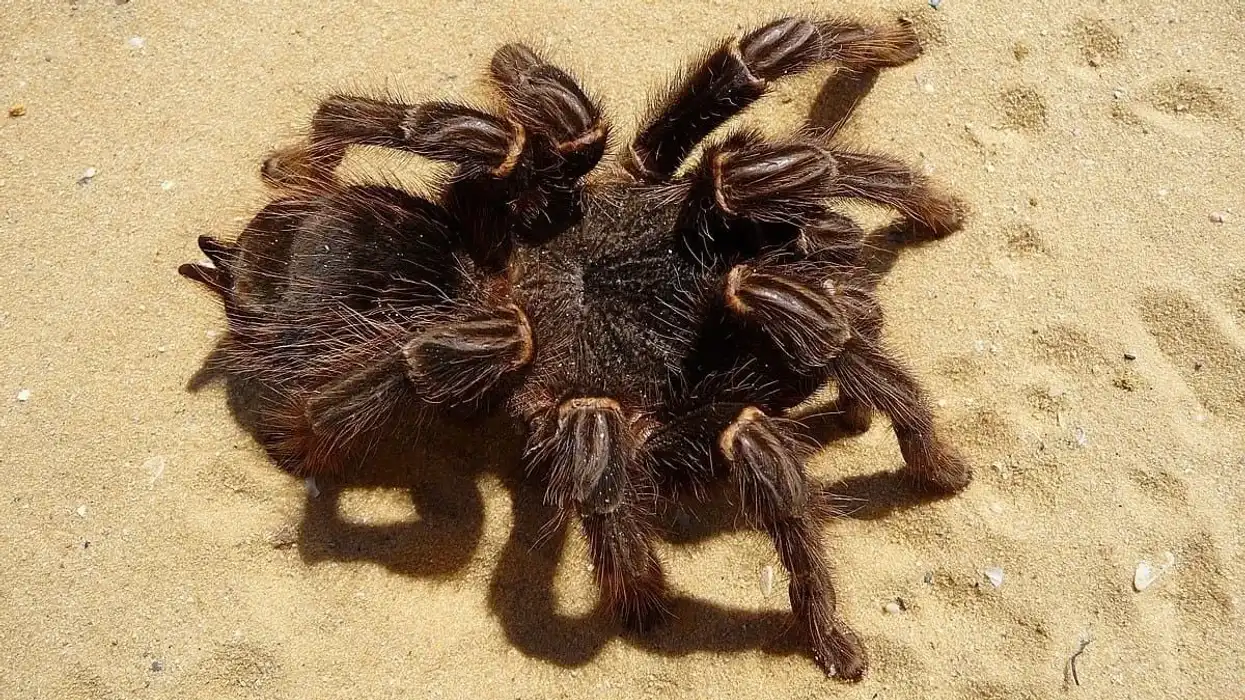The gray wall jumper spider, Menemerus bivittatus, is a small jumping spider species native to the African continent. They have a wide distribution range and are pantropical species.
They are found in India and North and South America, as well as Africa, in countries such as Venezuela and Colombia. Their common name comes from their habit of living on the walls of buildings. They are sexually dimorphic and diurnal.
They are in the order of Araneae. The male and female stripes on their carapace are vice versa. The description of the male varies from the female. The white color stripe pattern is more prominent in females, whereas, males have more black color stripe patterns on their bodies throughout their legs, carapace, and abdomen.
They prey on small flies, moths, and insects. The eggs are in a silk-like thread purse. These species are not aggressive until you provoke them. They are not poisonous and they might bite you only when provoked. Their bite does not require any medical assistance.
Learn some interesting and surprising facts about other spiders such as black house spiders and hobo spiders.
Gray Wall Jumper Spider Interesting Facts
What type of animal is a gray wall jumper spider?
The gray wall jumping spider is a common spider that can be found naturally on sunny days in artificial man-made habitats. They are known to be Old World tropics spiders with sharp, keen eyes with 360-degree visibility.
They are called jumping spiders because of their ability to jump frequently and fastly to forge their food. They have stripes patterned bodies.
What class of animal does a gray wall jumper spider belong to?
These jumping spiders belong to the class of Arachnida and the family Salticidae. They are from the genus Menemerus and the order Araneae. The Salticidae family of spiders are usually considered harmless and are famous for their good eyesight. Their scientific name is Menemerus bivittatus.
How many gray wall jumper spiders are there in the world?
The exact number of these species is not counted and is unknown globally.
Where does the gray wall jumper spider live?
The gray wall jumper, Menemerus bivittatus, has a wide range distribution which can almost be found with more probability in their habitat. These web spider species are considered to be native to Africa.
They can be found in India, America, Florida, Texas, California, and Paraguay. They are even found in the Caribbean islands, Venezuela and Colombia. The gray wall jumping spider can be seen in the artificial habitat of man, such as on the walls of buildings, like most small species of spiders.
What is a gray wall jumper spider's habitat?
Gray wall jumpers, Menemerus bivittatus, are commonly seen in the artificial habitat of humans, such as walls of buildings, dark corners of houses with dust, and on tree trunks. They are even found near the nestling birds' nest. They can be found anywhere in the green habitat because they have a wide range of habitats.
The webs of these spiders are normal to be spotted. They are mostly seen on sunny days and are diurnal. They live in pantropical regions.
Who do gray wall jumper spiders live with?
These species of jumping spiders do not stay in groups and are often seen alone. The gray wall jumper, Menemerus bivittatus, is not considered good at socializing and might end up killing others.
How long does a gray wall jumper spider live?
The Menemerus bivittatus lives for around one year.
How do they reproduce?
The reproduction of these jumping spiders is not very evident, but they are sexually dimorphic diurnal spiders. The female gray wall jumper is seen making their egg sac in dark-dingy areas such as unvisited corners of houses, cracked surfaces or walls, etc.
The female lays around 25-40 eggs in that egg sac, which is like a silken case. In this, only the female looks after her eggs until they hatch after a time period of three weeks.
Later on, the young spiders disperse. The female gray wall jumper spider egg sac takes the shape of a purse and appears to be a small cocoon.
What is their conservation status?
The conservation status of these species is of Least Concern as they have a wide range of distribution.
Gray Wall Jumper Spider Fun Facts
What do gray wall jumper spiders look like?

The description of the gray wall jumper spider is like any other small spider. They vary in color and texture, from gray to white cream. They are sexually dimorphic because the female body is larger in length than the male body.
Their body pattern is such that they have a flattened body surface on both the upper and lower sides. They have wisps of brown hair close to their large faces and bodies.
The males have a long black stripe with brown and white colors on the sides of their abdomens. The carapace and abdomen in males and females differ a lot. The mouth and carapace are also black and white in color.
They have eight legs – four on each side of their body. The male legs are less curved and more straight, touching the ground. The females are generally light in color and more brownish with a larger body.
The carapace is more white in color with broad stripe and black lateral lines or stripes on both upper sides. The legs of females are more curved and light in color in comparison to the males.
The juvenile appearance resembles females than males. In short, for better identification, gray or whitish spiders are the females and the ones that are more black in color are the males. The baby's abdomen is more similar to the female's.
How cute are they?
The Menemerus bivittatus is far from the list of cute creatures. Yes, they might attract your attention because of their soft, stripe patterned hairy structure.
How do they communicate?
The Menemerus bivittatus is less sociable and more cannibalistic. Their communication has not been evident and very little information is available in this regard.
How big is a gray wall jumper spider?
The Menemerus bivittatus is 0.31-0.39 in (0.78-0.99 cm). The males are 0.31-0.35 in (0.78-0.88 cm) in length, whereas the females are 0.31-0.39 in (0.78-0.99 cm) in length.
How fast can a gray wall jumper spider jump?
Most spiders can jump, however, the Menemerus bivittatus are known for their good jumping skills from one place to another using their silk threads. They can even jump with trapped crane flies.
How much does a gray wall jumper spider weigh?
The gray wall jumper spider weight is not known, however, due to its size, it must be quite negligible.
What are the male and female names of the species?
The male and female species of Menemerus bivittatus do not have any specific names and are called by the common name – gray wall jumper spider.
What would you call a baby gray wall jumper spider?
The babies of the gray wall jumper spider are called spiderlings.
Are they poisonous?
No, they are not poisonous, but they can bite you. The gray wall jumper spider bite can cause skin rashes and usually cures on its own. Their bite does not require any medical care or assistance.
Would they make a good pet?
The Menemerus bivittatus is too small to be a pet. Their habitation is artificial, man-made structures. So, if you want them to be your pet, you can find them in your house.
Did you know...
The Menemerus bivittatus was first described by the French naturalist, Leon Jean Marie Dufour, in 1831.
These species are shy and do not pose any harm to humans. They often shy away from their presence.
Most spiders hate the smell of tea tree, eucalyptus, and peppermint oil.
Do gray wall jumper spiders build webs?
Generally, they do not build webs because they are often seen targeting or chasing their prey.
Why are they called gray wall jumpers?
They are called gray wall jumpers because they commonly jump and do not build webs. They are seen on the walls of buildings.
Here at Kidadl, we have carefully created lots of interesting family-friendly animal facts for everyone to discover! Learn more about some other anthropods from our orb-weaver spider interesting facts and yellow sac spider fun facts for kids.
You can even occupy yourself at home by coloring in one of our free printable preschool spider coloring pages.










